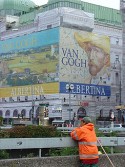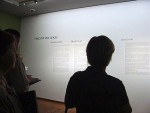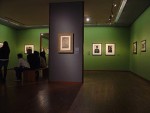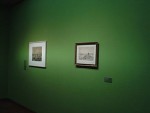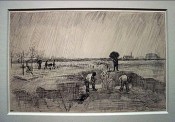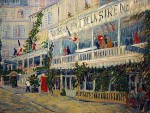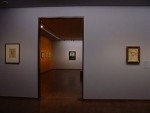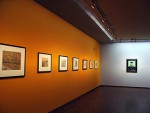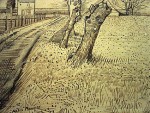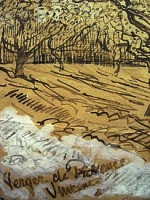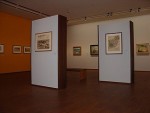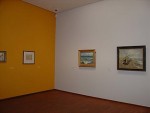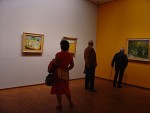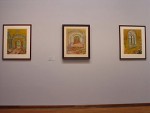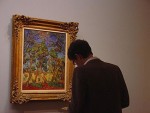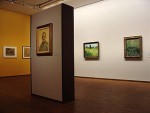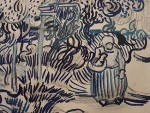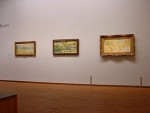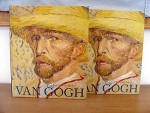The browser will either open the file, download it, or display a dialog.
|
Van Gogh: Heartfelt Lines Catalogue: 455 pages; 338 color illustrations, 32 b-w; bibliography |
|||||||||||||||||||||||||||||||||||||||||||||||||||||||||||||||||||||||||||||||||||||||||||||||
|
|
“To bring the art of drawing out of quarantine” became a mission statement of the new Albertina Director Klaus Albrecht Schröder long before he re-opened the meticulously restored museum. Assuming his post at the beginning of the millennium, Schröder accelerated renovations for the palace of Albert, Duke of Saxe-Teschen (1738–1822); the building behind the opera had housed his remarkable collection for two centuries and had closed for urgent repairs in the 1990s. At the Albertina’s initial exhibition in March 2003, visitors were surprised to see Edvard Munch’s drawings and prints installed side-by-side with paintings. Five years later for the van Gogh show, more than fifty public and private lenders the world over had been convinced: the Albertina, possessor of over a million works on paper, could maintain the 50-LUX light-level limit required for those fragile objects and still spotlight the sturdier paintings nearby. |
|||||||||||||||||||||||||||||||||||||||||||||||||||||||||||||||||||||||||||||||||||||||||||||||
|
Most viewers pass the sphinxes guarding the Albertina’s elegant stairway and ascend to the exhibition galleries knowing relatively little about the draftsman van Gogh. They might recognize a number of his legendary oils and, after publicity banners went up all over Vienna, a somewhat less familiar masterpiece, The Harvest (fig. 1). His brand is a known luxury good: Austrian press reports revealed that a federal law had to be changed to permit coverage of the 3-billion-Euro ($4.35 billion) insurance indemnity for the van Gogh show. Perhaps only schoolchildren arrive unaware of the dramatic contrast between the Dutch artist’s poverty and the present value of his works. Other museum goers come burdened with expectations and myths, a challenge to curators hoping to offer a new narrative for this iconic figure who, in a single decade of hard work, changed the course of modern art. Yet the organizers managed to establish in the Albertina galleries a cliché-free zone. |
||||||||||||||||||||||||||||||||||||||||||||||||||||||||||||||||||||||||||||||||||||||||||||||||
|
On the opening wall for example, the brief biography refers only tersely to the self-inflicted gunshot that ended van Gogh’s ten-year career as an artist (fig. 2). An economical, yet poetic text explains the subtitle of the show, “Heartfelt Lines,” or Gezeichnete Bilder:
As Schröder points out in his catalogue introduction, paper was not the only support this consummate draftsman used. That van Gogh drew with his brush on canvas has been observed in the past, but never so sedulously displayed and documented. From the earliest works through the wheat fields and cottages of his final summer, the attentive viewer is invited to follow van Gogh’s “fervid hand” as he “merged color and line to form an indissoluble bond within expressive ‘colored lines.’” Inspired, in part, by the concept of lignes senties mentioned in a letter to his brother Theo in 1889 (Letter 607), Heinz Widauer, curator of French art at the Albertina, and his assistant Stefanie Chaloupek laid out clues and evidence in a visual trail of 140 works (89 drawings and watercolors and 51 oils) more dazzling than the myths. |
||||||||||||||||||||||||||||||||||||||||||||||||||||||||||||||||||||||||||||||||||||||||||||||||
|
If drawing, as van Gogh wrote to his brother in the summer of 1882, is “the backbone of painting, the skeleton that supports all the rest (Letter 224),” the spinal column of this challenging exhibition is research done over the past decade at the Van Gogh Museum (lender of nearly half the works in the Vienna show), the Kröller-Müller Museum in Otterlo (with four drawings and three paintings on view), and the Metropolitan Museum of Art (with six loans). More than a third of the objects in Heartfelt Lines had hung in Amsterdam and New York in the major drawings exhibition mounted by the Met in conjunction with the Van Gogh Museum in 2005; the New York show included 113 works on paper, but only six oils.1 The industrious chief curator in Amsterdam, Sjraar van Heugten, and his assistant, Marije Vellekoop (contributors to both the Met and the Albertina exhibition catalogues), have published a four-volume catalogue of the drawings at the Van Gogh Museum, the final segment of which appeared in 2007.2 Also in 2007, Teio Meedendorp, author of an essay on the early drawings in Heartfelt Lines, published his catalogue of the holdings on paper at the Kröller-Müller Museum.3 A new edition of the van Gogh correspondence in both Dutch and French with parallel English translations – The Letters Project, anticipated for 2009 – will complete the paper trail.4 |
||||||||||||||||||||||||||||||||||||||||||||||||||||||||||||||||||||||||||||||||||||||||||||||||
|
Armed with freshened expectations and a roadmap for the last decade of the artist’s life, the visitor turns from the pale gray introductory wall to face the mossy green ambiance of the first and second rooms. The first stop for many viewers is Sorrow, made in The Hague in April 1882 as the artist struggled to teach himself to draw (fig. 3). Van Gogh’s meditation in pen and ink on the nude body of his pregnant companion, the sometime prostitute Sien Hoornik, is an appropriate introduction to the show’s thesis. Sien, a figure touched by Millet and Michelet, offers a preview of the apprentice draftsman’s quest for a strong-willed line. The image of naked despair in an early spring landscape emerges from the fusion of literary and artistic influences and compassion that propelled van Gogh at age twenty-nine, and announces a reverent observation of nature that will enrich the artist’s trajectory we are about to follow. |
||||||||||||||||||||||||||||||||||||||||||||||||||||||||||||||||||||||||||||||||||||||||||||||||
|
The exhibition path, lined with vegetation, begins on the wall near the entrance. The earliest drawing in the show is Marsh with Water Lilies (Virginia Museum of Fine Arts, Richmond, Collection of Mr. and Mrs. Paul Mellon; F 845). Working with a graphic touch close to etching, van Gogh used a reed pen already in June 1881 to define this swamp. He added his signature and an ink frame, evidence that he understood he had created a small treasure worth selling or giving away.5 The adjacent drawing, Country Road (F 1089), made the following spring in The Hague, shows that he had begun to view his subjects through a perspective frame, a device he would continue to use until mid-1888 and, rarely, even in his final years. |
||||||||||||||||||||||||||||||||||||||||||||||||||||||||||||||||||||||||||||||||||||||||||||||||
|
The second room focuses on images from Nuenen, near Eindhoven, where van Gogh was living with his parents. Between December 1883 and August 1884, still thinking of becoming an illustrator, he produced some thirty works depicting the local weavers; three are in the Nuenen room of the show, including the delicate drawing Weaver with a Baby in a Highchair (F 1118), thought to be inspired by George Eliot’s Silas Marner. Along one wall, we follow van Gogh outdoors in the early spring of 1884 with five large pen drawings of his father’s vicarage garden and nearby ditches and ponds. Having completed The Potato Eaters in the spring of 1885, van Gogh concentrated that summer on the human figure outdoors, drawing laborers and harvesters in black chalk on large wove-paper sheets. A small oil of a peasant woman (F 98, Koninklijk Museum voor Schone Kunsten, Antwerp) is aptly compared to the Peasant Woman Gleaning (F 1269, Kröller-Muller Museum); in 1897 Ambroise Vollard sold this magnificent monumental chalk drawing to Siegfried Bing, who resold it three years later. |
||||||||||||||||||||||||||||||||||||||||||||||||||||||||||||||||||||||||||||||||||||||||||||||||
|
The artist left Nuenen suddenly in November 1885, and the exhibition installation mirrors this abrupt departure. At the end of the Nuenen room, after a single pencil study of a standing nude from van Gogh’s three-month stay in Antwerp, the viewer arrives in Paris. The artist himself reached Paris around March 1, 1886, just before he turned thirty-three. Two somber drawings suggest late fall, both depicting an urban cemetery in the rain, where two workmen dig in or clear a common grave – a fosse commune – as a child’s casket is borne across the middle ground (fig. 4). The smaller and probably earlier version (F 1399) is one of the Albertina’s two van Gogh drawings, acquired by trade sometime between 1934 and 1947 (fig. 5).6 This lugubrious subject is assumed to be a literary reference to the funeral of the Goncourts’ heroine in Germinie Lacerteux or of Zola’s thwarted artist Claude Lantier in L’Oeuvre. The diagonal rain is reminiscent of one of the tests of skill for an ukiyo-e artist. Van Gogh, who had started a collection of Japanese prints in Antwerp, began in Paris to haunt Bing’s storeroom to study, buy, and sell more of the genre; perhaps he already owned Hiroshige’s Bridge in the Rain (his impression is in the Van Gogh Museum), or similar feats of woodblock printing. |
||||||||||||||||||||||||||||||||||||||||||||||||||||||||||||||||||||||||||||||||||||||||||||||||
|
Confusion in the literature on dating the graveyard images reflects a problem in documenting the artist’s Paris period: he was living with, not writing to, his brother. Van Gogh famously lightened up and started to add color to his Dutch palette, but there is only one dated drawing to mark his progress. In the room entirely devoted to his stay in the French capital, the walls are the pearl gray of a Parisian sky. Color explodes on all sides, chiefly from the summer of 1887: brilliant Japanese-influenced watercolors, paintings demonstrating his new woven brushstrokes of slashing lines and dots, a pair of modest Montmartre sunflowers (the only ones in the show, except among other garden flowers), and two versions of a restaurant on the Seine (fig. 6). Scholars have referred to a yawning gap in drawings from the Paris period, as van Gogh reacted to the shock of realizing that his painting was old-fashioned and needed updating. Schröder’s catalogue introduction sees it otherwise. The artist, Schroder writes, responded to the color-dominated new painting with “drawn pictures,” his brushstrokes reinstating “the line as a genuine expression of identity.” Self-portrait studies exploring that identity flank the door to the next room, a reminder that most of van Gogh’s self-portraits were made in Paris (fig. 7). |
||||||||||||||||||||||||||||||||||||||||||||||||||||||||||||||||||||||||||||||||||||||||||||||||
|
Walls the color of French’s mustard in the fourth room announce Arles, where the artist, looking for Japan in the South, arrived in February 1888. Remarkable roadside landscapes confirm that, as van Gogh told Theo, he had found “good reeds” (Letter 478) in Provence and was deploying them with increasing skill (fig. 8). One drawing with the characteristic heart-shaped dots of his reed pen was dated by the artist, “Arles Mars 88” (fig. 9). Another from this series he signed under the title “Verger de Provence” (fig. 10). Tramping the countryside in his footsteps, exhibition visitors may come to imagine themselves on a first-name basis with “Vincent.” This feeling of intimacy, mixed with awe, is especially strong in the two Arles galleries, one-third of the show (fig. 11). The artist’s letters (and the sketches they contain) again help to date his works; he was producing something like a hand-written blog. At the end of May, for example, he informed Theo that he was leaving Arles to cross the Camargue by coach for a few days on the coast at Les Saintes-Maries-de-la-Mer. Et je veux arriver à un dessin plus volontaire et plus exagéré, Vincent declared in one of his most important statements of artistic purpose (Letter 495).7 |
||||||||||||||||||||||||||||||||||||||||||||||||||||||||||||||||||||||||||||||||||||||||||||||||
|
Although van Gogh missed by a few days the colorful annual pilgrimage, he attained in this fishing village a miraculous synthesis of his drawing and painting. Selecting two canvases and four drawings related to the excursion to the Mediterranean, the curators stunningly demonstrate this conjunction (fig. 12). A corner display presents six variations relevant to the exhibition’s theme: two free-hand drawings (without the perspective frame) and a seascape oil study made on the spot, another oil of fishing boats produced by tracing a drawing in his studio after he returned to Arles, and two refined répétitions from the group of thirty-two such drawings after his own paintings made later in the summer. Then the momentum of the works on paper is unavoidably broken by a chronological gap in the material. During the nine weeks at the end of the year when Paul Gauguin shared his Yellow House, van Gogh all but abandoned drawing. Tension between the two escalated, and their artistic disagreements and alcohol abuse led to an episode just before Christmas 1888 in which van Gogh mutilated himself. Gauguin left for Paris, bringing to a sudden halt the project for a collaborative Studio of the South. |
||||||||||||||||||||||||||||||||||||||||||||||||||||||||||||||||||||||||||||||||||||||||||||||||
|
Another corner of the second Arles gallery includes, next to a wheat field and a verdant park, a still-life in the Dutch tradition painted shortly after the crisis and the artist’s first hospitalization in Arles (fig. 13). Alarmed by his nervous collapse, he placed among his personal remedies against suicide – wine, tobacco, and a pipe – a stamped envelope from his brother. A relapse in February led to his return to the hospital. Its arcaded courtyard (cat. 103, F 1467), drawn just before van Gogh committed himself to the asylum Saint-Paul-du-Mausole on May 8, 1888, marks the beginning of the next-to-last room – the works from Saint-Rémy. Here the installation depicts confinement: three interiors of his new residence occupy one wall of a small side room (fig. 14). Even the field that van Gogh saw from his window was enclosed by a wall (cat. 111, F 1547). A large oil of the asylum façade expresses the joy of painting on a brilliant fall day, and he reveled in drawing the tangle of vegetation in the overgrown park (fig. 15). His portrait subjects were the asylum gardener and an attendant, and finally he painted an allegory of detention inspired by a wood engraving of Newgate Prison after Gustave Doré (fig. 16). |
||||||||||||||||||||||||||||||||||||||||||||||||||||||||||||||||||||||||||||||||||||||||||||||||
|
Although we know the end of the story, the final room dedicated to Auvers raises hopes with vigorous drawings made within days of his arrival in the North (fig. 17). Five “double-square” (c. 20 by 40-inch) decorative canvases assembled to close the show were selected from thirteen such rural images painted during the last month of van Gogh’s life. The works in the last room yield another look at the slashes and squiggles, stripes and stipples: the colored lines in which drawing and painting merge. By the time viewers reach the final wall, it is obvious that the best known of the thirteen double-squares, Wheatfield with Crows (F 779), is not in the exhibition; many visitors have been told—falsely—that it was van Gogh’s last painting (fig. 18). Then, as they approach Rain—Auvers and head for the exit, they may discern a small flock of crows in flight at the very center of the picture, slashed—like the Paris cemetery—with a fierce shower of lines. |
||||||||||||||||||||||||||||||||||||||||||||||||||||||||||||||||||||||||||||||||||||||||||||||||
|
Fifty years ago, the two versions of Cemetery in the Rain, as well as the second drawing from the Albertina’s own collection, Road with House and Trees (F 1502), hung in the last major van Gogh exhibition in Vienna before Heartfelt Lines. In 1958, the 33-page catalogue had a dozen illustrations at the back. By contrast, the hefty catalogue in 2008 has more than 350 illustrations, with glorious details and enlarged double spreads (fig. 19). The book contains fine and apposite essays, with careful cross-references to the catalogue entries. Its usefulness, however, is seriously compromised by the absence of an index or even a checklist. One has only to consult the exemplary indexes provided for the Met catalogue in 2005 to see what is necessary for a book of this size to pull its weight. To navigate the Albertina catalogue, the reader can resort to crude guerilla indexing by downloading and adding catalogue numbers to the alphabetical list provided under “Recent Exhibitions” on the admirable website created by David Brooks (www.vggallery.com).8 But only with a proper index could a reader consult all the references to Hiroshige or Millet or retrieve the many gems in the text, such as the reminder in Martin Bailey’s essay (77) that van Gogh and the American illustrator Joseph Pennell may have crossed paths in Arles. Another few pages would have made the record of this bold and yet somehow tranquil, conscientious, and visually satisfying exhibition a permanent pleasure. |
||||||||||||||||||||||||||||||||||||||||||||||||||||||||||||||||||||||||||||||||||||||||||||||||
|
Jane Van Nimmen |
||||||||||||||||||||||||||||||||||||||||||||||||||||||||||||||||||||||||||||||||||||||||||||||||
|
1. Colta Ives, Susan Alyson Stein, Sjraar van Heugten, and Marije Vellekoop, Vincent van Gogh: The Drawings (New York, Amsterdam, New Haven and London: The Metropolitan Museum of Art, Van Gogh Museum, and Yale University Press, 2005). 2. Sjraar van Heugten, Vincent van Gogh: Drawings, vol. 1, The Early Years, 1880–1883 [1996]; vol. 2, Nuenen 1883–1885 [1997]; Marije Vellekoop and Sjraar van Heugten, vol. 3, Antwerp and Paris [2001]; Marije Vellekoop and Roelie Zwikker, vol. 4, Arles, Saint-Rémy and Auvers-sur-Oise (Zwolle and Amsterdam: Van Gogh Museum, 2007). 3. Teio Meedendorp, Drawings and Prints by Vincent van Gogh in the Collection of the Kröller-Müller Museum ([Delft] and Otterlo: Thieme Grafimedia Groep and Kröller-Müller Museum, 2007). 4. The Letters Project, launched in 1995, is a joint undertaking of the Van Gogh Museum and the Huygens Institute in The Hague. 5. Oddly, the frame lines are hidden by the mat in the show, and although they are mentioned in the entry text, they are cropped in the catalogue reproduction (cat. 1). Compare New York 2005, figs. 12 and 89. 6. Barbara Dossi, Albertina: The History of the Collection and its Masterpieces (Munich, London, New York: Prestel, 1999), plate 56. 7. The Letters Project will hopefully settle on an English translation of volontaire in Letter 495. In the Albertina exhibition catalogue it appears both as “spontaneous” (266) and the rather different “deliberate” (in Fred Leeman’s essay, 87). Vellekoop and Zwikker 2007 (121) also opt for “deliberate.” 8. On request, I can provide a copy of the Vincent van Gogh Gallery list enhanced with Albertina catalogue numbers. |


